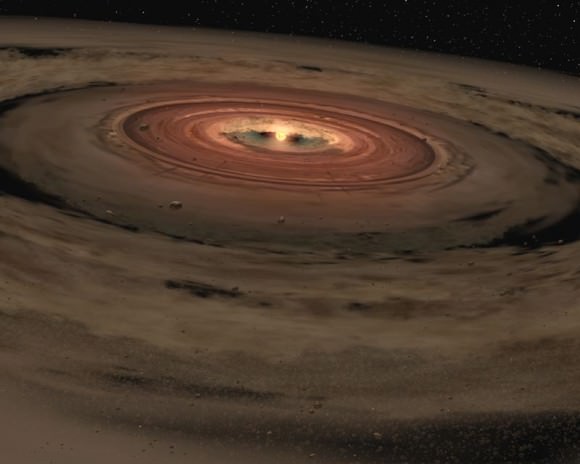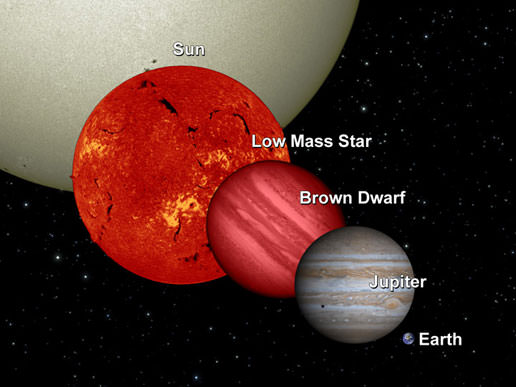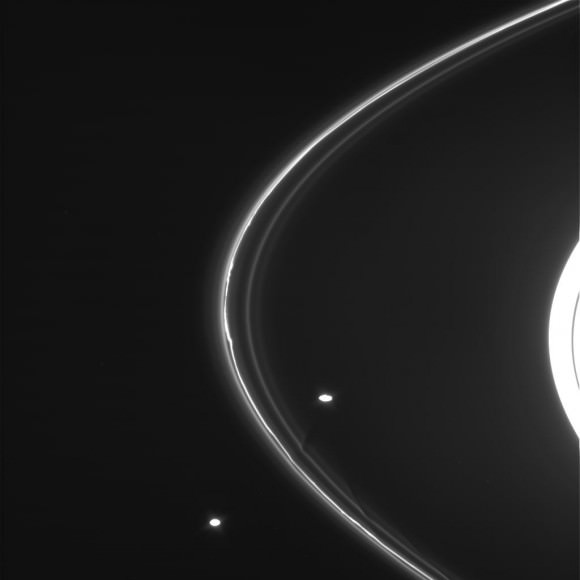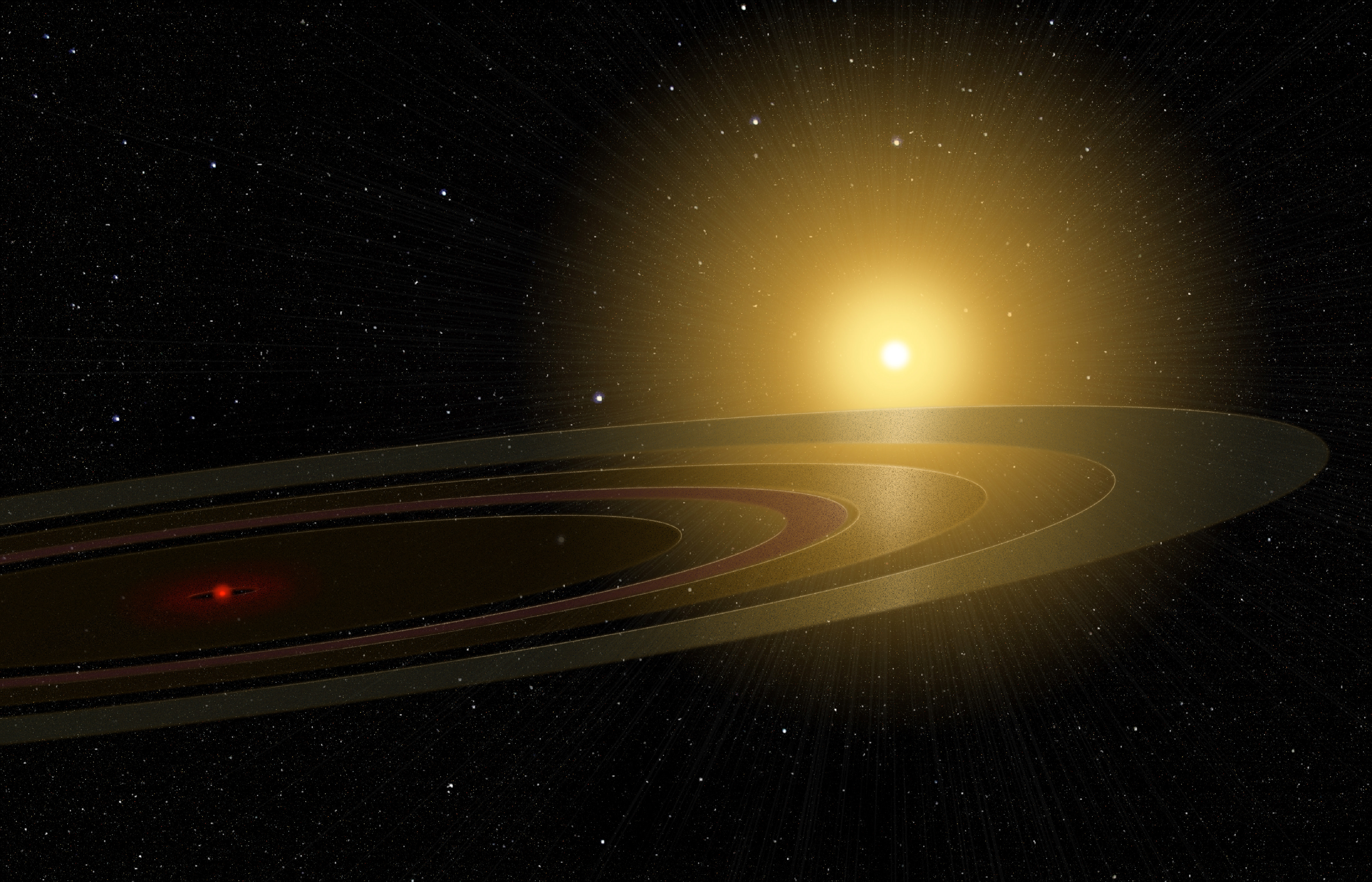[/caption]
By analyzing the silhouette of an exoplanet passing in front of its parent star some 420 light years from Earth, a team of astrophysicists has discovered an exoplanet that just might turn out to be Saturn’s cosmic doppelgänger.
Assistant Professor of Physics and Astronomy at Rochester University Eric Mamajek and graduate student Mark Pecaut studied data from the international SuperWASP (Wide Angle Search for Planets) and All Sky Automated Survey (ASAS) project.

They were looking at the star’s light pattern; periodic dimming is a telltale sign that a planet is passing in front of it. A spherical planet will dim a star’s light regularly. As seen from Earth, the star’s light will dim as the planet starts to cross it, getting darker until it reaches a point of maximum dimness – the point when the planet is directly between the Earth and the star. Then, the light will get brighter at the same pace as it previously dimmed.
But in December 2010, they noticed something odd. As they analyzed data gathered over a 54 day period in early 2007, the star 1SWASP J140747.93-394542.6 dimmed irregularly. The object passing in front of it couldn’t be a spherical planet, so what was it?
The object had an elliptical silhouette, it was blocking the star’s light in an intermittent and irregular pattern, and was obscuring a significant portion of the star’s light. At one point in the pass, 95 percent of the star’s light was obscured, most likely by dust.
“When I first saw the light curve, I knew we had found a very weird and unique object,” said Mamajek. “After we ruled out the eclipse being due to a spherical star or a circumstellar disk passing in front of the star, I realized that the only plausible explanation was some sort of dust ring system orbiting a smaller companion—basically a ‘Saturn on steroids.'” Rings were the likeliest culprit of the oscillating dimness in the star’s light.
“This marks the first time astronomers have detected an extrasolar ring system transiting a Sun-like star, and the first system of discrete, thin, dust rings detected around a very low-mass object outside of our solar system,” said Mamajek. But there are still some major questions about what exactly has been discovered.

It could be a very low-mass star, brown dwarf, or gas giant planet. But it’s still too early to know either way. To arrive at some answer, they will need to determine the object’s mass.
A planet that size will exert a gravitational pull on its star in the same way that Jupiter tugs on the Sun. The amount of wobbling this gravitational interaction creates can reveal the mass of the object and give astronomers a clue about what it might be. If it has a mass between 13 and 75 times that of Jupiter, it will likely be a brown dwarf. If it’s any smaller, astronomers will know that it’s likely a planet more similar to Saturn.

The object itself isn’t the only interesting part of the find; Mamajek is particularly interested in the gaps between the apparent rings that are optically similar to those around Saturn. Gaps are usually indicative of objects within the rings with enough gravitational influence to shape them, like Saturn’s shepherd moons.
But even if the rings turn out to be a cloud of dust, the discovery will be no less exciting. If the object turns out to be a brown dwarf with a cloud of dust, Mamajek thinks it’s likely his team has observed the late stages of planet formation. Or, if the object is a large planet, they may be observing the formation of moons around the giant planet.
Either way it’s an awesome discovery. As cool as finding Saturn’s twin would be, watching moons form around another planet would be equally fascinating. The team’s findings will be published in an upcoming issue of the Astronomical Journal.
Source: University of Rochester.


It was just a couple of weeks ago there was an article here about the vague possibility of detecting exoplanet rings… how prophetic 😉
Here are the two previous Universe Today articles where the detection of Saturn-like rings was discussed. (We speculated that Kepler might spot them.)
http://www.universetoday.com/90745/forget-exoplanets-lets-talk-exomoons/
http://www.universetoday.com/91269/forget-exomoons-lets-talk-exorings/
But Epsilon Aurigae might be considered the first known example of eclipsing exorings, and we’ve known about it for decades.
http://www.universetoday.com/62159/astronomers-image-mysterious-dark-object-that-eclipses-epsilon-aurigae/
Here’s the link to the relevant paper:
Planetary Construction Zones in Occultation: Discovery of an Extrasolar Ring System Transiting a Young Sun-like Star and Future Prospects for Detecting Eclipses by Circumsecondary and Circumplanetary Disks.
As always; amazing
We are seeing Carl Sagan’s billions and billions coing to fruitition.
LC
Ivan is sleeping eh!
[] I am old enough to remember the low-resolution, naively simplistic(?) concepts of Saturn’s distant, frame-dated Ring picture. Yet, with voyagers’ a passage, and the astonishing views of powerful lens, the details upon DETAILS which emerged from broad-encircling bands of past telescopic sight!
Known Rings, and their spacious divisions, incredibly, subdivided into innumerable Ringlets: sparse and dense, broad and narrow, braided and rippled – in their hundred of thousands, comprised of “particles dancing in formation”*! The bland Rings of misconception, suddenly, dramatically emerged ( as complex crystallization of frost from morning dew ) into perplexing patterns of electro-magnetic relief, and surreal brush-strokes of gravity’s ghostly wakes.
The simple surface concepts of low resolution, became exciting depths of magnified detail!
[] More generally, regarding celestial rings: I wonder, if somehow we could obtain
very high-resolution images of star disks ( perhaps of a certain kind, whatever their actual nature, whether in spreading of youth, in “theory” told, or the fading of age, from another model to behold: is it the cry of infancy we see, or the groan of age we hear? ), what would those impossibly detailed pictures display? Would they transform into celestial plains of myriad ringlets of unexpected detail? And like the studies multiplied from Saturn’s Rings in space, an array of new questions to unfold.
Gravity’s orbital dynamics holds the answers, I presume.
Of brilliantly roaring Black Hole disks; or the gentler flow of a Galaxy’s misty stellar streams; even in the grand space of theri elegant clusters, of members waltzing through glittering corridors of time, in depths of unseen details, who can know?
[] The attractive illustration of star 1SWASP J1…2.6(?) seems a bit fanciful, almost akin to an artist’s representation of the hypothetical planet-formation model of world-creation. But then, in its dusty frame, as it goes for the big star-system, so would go for the smaller planet-moon, I guess.
Thus far, it appears as it has ever been, on Earth our out in Space — the closer one looks, instrumentally or otherwise, the greater the complexity of detail, and intricacy relationship ( only ending at the subatomic level – yet, even there…! ).
_________________________________________________
* Why does Saturn have rings? NASA’s The Space Place.